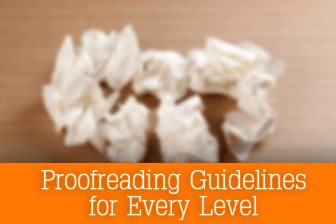
It can be difficult to incorporate proofreading activities into an ESL class. However there are strategies that you can employ at every level to get students feet wet with finding errors and making corrections.
Get out those red pens and show students that they will learn a lot by editing not just their own work, but their classmates’ as well.

Proofreading Guidelines for Every Level
-
1
Grammar and Spelling Correction
One fun way to informally introduce proofreading is to display some sentences with mistakes on the board. Make sure the sentences are applicable to the level you are teaching and if you want to get really creative, you can even pull the sentences from the students’ own work at random. Ask students how many mistakes they can find in each sentence. Have them copy the sentences down or give them the same examples on a worksheet. You could have them work in pairs or individually telling them first to circle the mistakes they can find and if they can, try to correct them. Allow them to use their books, notes, dictionaries or whatever other resources might be helpful.
To make this a bit more fun you could give them a time limit per sentence and ring a little bell or make a sound when they are to progress to the next sentence. Do this maybe five to seven times. Then challenge the students. At this point you could make this into a team game or keep it individual, but you really want to make sure you get all the students up to the board. Give them colored markers that correlate to what kind of mistake they are correcting, like red for spelling, green for grammar, and blue for punctuation. Allowing the students to practice first in their books and then next at the board gives them a chance to analyze the mistakes and consult their friends and notes. You can also change this up by asking them to target very specific grammar and spelling. The more they get accustomed to doing it, the sharper their red pens will become. You can then do quick grammar lessons at the board, and have students explain why they made certain corrections.
-
2
Proofreading Symbols
You can find lots of worksheets and online resources that detail the proofreading symbols. Depending on the level of the class you can choose to go into the symbols as deeply or as simply as you deem suitable. Students enjoy the use of a visual mechanism for noting errors, but you also want to be careful not to introduce too many symbols at one time. Introduce them in groups and then apply them. Once the students get comfortable using them, you can then add in more symbols to their repertoire.
Here are a few examples:^ Insert (can be used to insert words or punctuations) (the) Delete this word ( ) Close this space (if you have deleted something and need to delete space) 
Delete 
Transpose or reverse items 
New Paragraph One way to give them practice using the symbols is to give them a handout or homework assignment that contains a lot of errors. Have them find as many mistakes as they can while utilizing new marks they have learned. As a follow-up you could also have them take a piece of their own writing and attempt editing that as well.
-
3
Peer Correction
One very useful method to get students interested in proofreading is to have them do peer correction. This may seem daunting for students at first, but if you very clearly break down what types of mistakes they should be looking for, that can alleviate a lot of the tension. For example, if you have a fairly low level class, they will not be able to just pick up a piece of writing and start finding mistakes and correcting them. You will need to clearly define what they are looking for and how to correct it. Perhaps you had the students use 10 vocabulary words in the writing. Have the proofreaders search for those familiar words and correct any misspellings. Also, if you have them underline any other mistakes they find they can then work in pairs to attempt to correct and or define the mistakes.
It is best to put the students into groups and have them exchange papers and let them find each other’s errors. It is too difficult to expect the writer to catch his own errors. It will benefit their writing by having another pair of eyes finding those common mistakes that all students make who are new to writing.
For a higher level class, you could make the peer editing much more challenging. You could hand out the papers randomly and have students proofread the paper that they receive. Then set a time limit, not too short, because you want to give them time to examine the writing and find and correct errors. After maybe 10 to 15 minutes have students swap papers again. The more often you have the papers circulating the better because the most important part of peer-to-peer proofreading is to make sure the papers circulate around the room. That way, the students get to proofread several papers and the writers get several eyes examining their work. Students also get the chance to show off their proofreading abilities and this definitely helps them develop sharpened grammatical habits and confidence.
Having students work on proofreading and editing can significantly increase not just their confidence, but also their mastery of the language.
It is important for students to be able to reach the point where they can self-assess their own work as well help those around them.
P.S. If you enjoyed this article, please help spread it by clicking one of those sharing buttons below. And if you are interested in more, you should follow our Facebook page where we share more about creative, non-boring ways to teach English.







